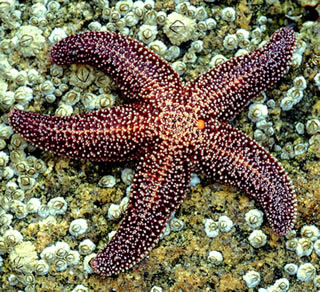Sea stars being suffocated by bacteria

A sea star rests on a barnacle-covered rock.
January 28, 2021
What was once believed to be a deadly sea star disease caused by a viral infection was actually caused by bacteria. Multiple types of bacteria live within millimeters of sea stars’ skin and deplete the oxygen from the surrounding water which suffocates the sea stars. These microbial bacteria thrive in warm waters with high levels of organic matter, according to Science News.
The low oxygen environment created by these microbes can cause sea stars to essentially melt into a puddle of goo, named sea star wasting disease. Symptoms include decaying tissue and loss of limbs cause the sea star to appear as if it is melting. This disease was first discovered in 2013 off the Pacific Coast of the United States when massive populations of sea stars died.
Copiotrophs, a type of bacteria, thrive in environments with lots of nutrients and were present around the sea stars at higher levels than normal around the time that they started experiencing symptoms. Other bacterial species that only survive in environments with little to no oxygen were also present.
When an experiment was completed in the lab by depleting oxygen from the water, a similar effect occurred in 75 percent of the sea stars. Sea stars diffuse oxygen over small external projections called skin gills in order to breathe. The lack of oxygen in the water causes the sea stars to struggle for air. The depletion of oxygen could cause massive cell death, thus potentially leading to animal degradation.
Scientists are worried these mass killings of sea stars may get worse with climate change. With climate change, comes warmer waters and warmer waters have a lower oxygen concentration that that in colder water.


